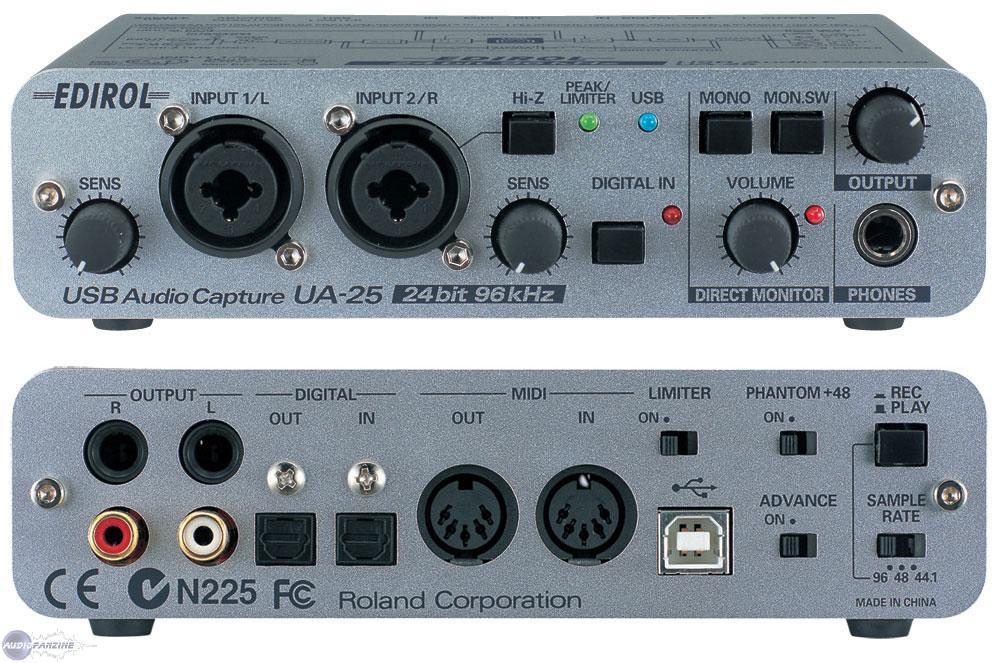View other reviews for this product:
« Good on paper, but ... »
Published on 02/18/13 at 01:52Having foolishly burnt my Edirol UA20, I bought it to replace, especially for XLR inputs.
I used to save a little bit of everything (guitar, keyboards, vocals, sound effects). it found itself with a guitar input, a SM58 placed before a mouth or a guitar amp cabinet, condenser microphones, a keyboard output, etc.. I also have misused the midi input to connect a keyboard master.
UTILIZATION
Software side, I've never had a problem. Asio drivers had no audible latency (5 ms Tracktion told me). I recorded still 16bit 44KHz, so that I could record in stereo while having the sound from the computer back (which is not possible in 96 KHz, the card only works in one direction both, either by reading or recording).
on the other hand, black spot: a big interference clearly audible in the main output. This was due to the grounding and, in fact, using it on a laptop on battery power, the problem disappeared. Making in practice, the main output was not usable and had to settle for the headphone jack (!). There was a way around the problem by not connecting the PC to the earth, I am not too risky to do over the long term ...
GETTING STARTED
Install the driver, plug in the sound card. Everything worked nickel the first time. As I said earlier, the only "incompatibility" that I met was electric. At the software level, no problem.
I do not remember having read a lot of the manual. Everything is marked on the map itself.
OVERALL OPINION
I used it for two or three years (I bought a firewire multimix after, just to get the card directly integrated into the mixing desk). I had the UA20 before, but have not really tried other models at the time.
Without this interference problem, this card would have been perfect. Not very expensive, and with everything I needed (XLR inputs, phantom power, input-output noon). But here goes. To minimize interference, I can connect the headphones to the mixer, then find a point of balance on the volume of said headphone jack (too low or too high, the increased interference) and compensate Following the table itself.
It's a shame ...
I used to save a little bit of everything (guitar, keyboards, vocals, sound effects). it found itself with a guitar input, a SM58 placed before a mouth or a guitar amp cabinet, condenser microphones, a keyboard output, etc.. I also have misused the midi input to connect a keyboard master.
UTILIZATION
Software side, I've never had a problem. Asio drivers had no audible latency (5 ms Tracktion told me). I recorded still 16bit 44KHz, so that I could record in stereo while having the sound from the computer back (which is not possible in 96 KHz, the card only works in one direction both, either by reading or recording).
on the other hand, black spot: a big interference clearly audible in the main output. This was due to the grounding and, in fact, using it on a laptop on battery power, the problem disappeared. Making in practice, the main output was not usable and had to settle for the headphone jack (!). There was a way around the problem by not connecting the PC to the earth, I am not too risky to do over the long term ...
GETTING STARTED
Install the driver, plug in the sound card. Everything worked nickel the first time. As I said earlier, the only "incompatibility" that I met was electric. At the software level, no problem.
I do not remember having read a lot of the manual. Everything is marked on the map itself.
OVERALL OPINION
I used it for two or three years (I bought a firewire multimix after, just to get the card directly integrated into the mixing desk). I had the UA20 before, but have not really tried other models at the time.
Without this interference problem, this card would have been perfect. Not very expensive, and with everything I needed (XLR inputs, phantom power, input-output noon). But here goes. To minimize interference, I can connect the headphones to the mixer, then find a point of balance on the volume of said headphone jack (too low or too high, the increased interference) and compensate Following the table itself.
It's a shame ...



